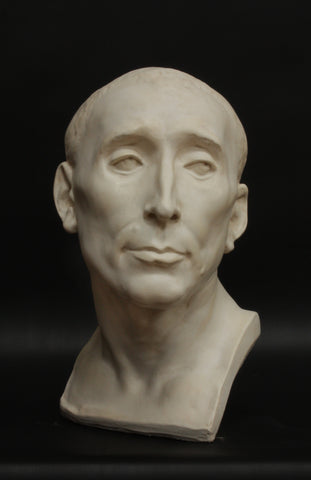|
We thought you might like to meet more of us who work here at the Gallery, so the newsletter team interviewed one of the plaster casters, Nick Batzell! Read on to hear about what he does and his thoughts on the Giust Gallery/Caproni Collection.

Nick with a brand-new cast he created of the head of Michelangelo’s David. View a video of the casting here!
Nick, tell us about your interest in art.
Growing up I had always been really interested in the Ancient World. There was something especially exciting about Greek myths to me. When I was a teenager I studied Latin which gave me an even deeper connection to the history and tradition of the Ancient World. So there was always a love of the stories and history that so many of the Giust pieces refer to.
Did you have training or experience in art or sculpture before coming to the Gallery?
Well, in college I studied metalsmithing which gave me an intense appreciation for the Nature of Craft and how things are put together in general. It also taught me that if you want to learn how to make something, you have to be appreciative of the material that you use.
Does that inform what you do at the Gallery?
Absolutely. When casting plaster I've learned how the plaster and the molds really direct the flow of work. After you mix it, the plaster goes from liquid to solid in around 20 to 30 minutes. During that time it takes on different viscosities and consistencies. From minute to minute and even second to second it’s like using a different kind of material. Also, every mold is a little different because every sculpture is different. I have to memorize every detail so I can make sure the proper time and attention is paid to delicate and hard-to-reach details as well as to the large structural aspects.
Do you have a favorite part of the casting process?
Well, the variety is incredible. But the variety can be the worst part, too!
Really?
It's two sides to the same coin. Each of the molds has its own personality. The head of Venus de Melo, for example, is so nice and easy it feels like a collaborative process. Some pieces are intimidating just because of their scale, like the head of Michelangelo’s David. Some, like the Laocoon Mask, can just be fussy and irascible co-workers. I've been doing it long enough to know who I work best with. Casting is a craft. I have to let the materials dictate how I work. If I try to force them to do exactly what I want, I’ll lose every time. The molds and materials do what they want, when they want. No more, no less.
What’s your favorite piece in the Collection and why?
Niccolo da Uzzano by Donatello. It has everything that stands out about the Giust Gallery in one piece: harmony of form, accessible connection with the work, but with a deep air of mystery and personality within the piece. The importance of Donatello in the history of sculpture cannot be overstated. Few people recognize the advances he made and influence he had. We know that Michelangelo saw Donatello’s St. George on the Orsanmichele when he studied in Florence. It doesn't hurt that we have the same first name, too.

Niccolo da Uzzano Item #179
What do you think connects all the pieces in the Collection to you?
Wow, hmmm, give me a second. Ok, I think that's really it there: the aspect of time. The collection encompasses thousands of years of art history. But it's every day for me, too. When I make a cast, I get to breathe life into a piece of art every day. And even though I only spend one or two days making any piece, it goes on and has a life long after we've worked together. Luckily, it gives back beauty for months, years, decades; as long as people see it or think about it, it lives on. A worthwhile investment of my time if you ask me.
________________________
|